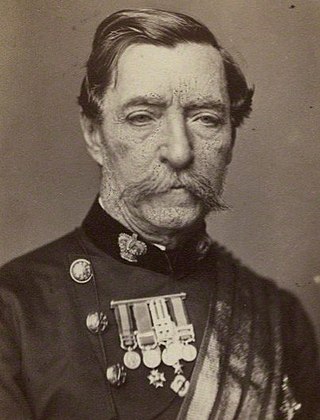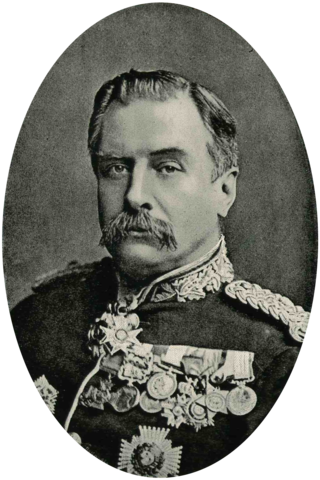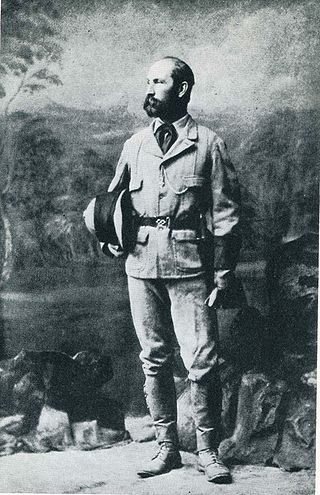See also
![]() Works related to The Private of the Buffs at Wikisource
Works related to The Private of the Buffs at Wikisource
The Private of the Buffs (or The British Soldier In China) is a ballad by Sir Francis Hastings Doyle describing the execution of a British infantryman by Chinese soldiers in 1860.
During the Second Opium War, an Anglo-French expedition landed in China and marched towards Peking in order to force the compliance of the Treaty of Tientsin. On 13 August 1860, during the attack on the Taku Forts—大沽炮台, in Chinese, or dàgū pàotái—Chinese troops captured two British soldiers and a group of coolies. (Some contemporary accounts record the latter as Sikh soldiers from India, and indeed the poem refers to "dusky Indians")
The details of the subsequent events are not well-recorded, but according to reports in The Times, one Private John Moyse, of the 3rd (East Kent) Regiment (commonly known as "the Buffs") refused to kowtow to his captors. [1] Apparently he had "declared he would not prostrate himself before any Chinaman alive," and as a result, he was summarily executed. The poem refers to Moyse as a young Kentish farmboy; however it is unknown for certain. However, the poem was written on the strength of newspaper reports, and it is likely that Doyle was unaware of the discrepancies.
Despite the report in The Times, there is speculation concerning whether the incident took place as was popularly supposed. Garnet Wolseley, who was present at the taking of the Taku forts, insisted that "The man belonging to the Buffs was either killed, or 'died of drink,' as the Chinese say." The source of the information—a soldier in the 44th (East Essex) Regiment of Foot was, according to Wolseley, not reliable. "His mind, indeed, seemed to be unbalanced, as in addition to the untruths he told, he talked utter nonsense about what he pretended he had overheard his captors say." [2]
D.F. Rennie, a doctor with the British troops, also denied that the incident took place. [3] The Manchester Times reprinted Rennie's account on December 2, 1865, with the conclusion
Thus, it would seem that this unfortunate man, who, through the romancing propensities of his comrade of the 44th, and the ready ear for 'sensationalism of the Times correspondent, was believed by the deluded British public to have been decapitated because he would not kow-tow to Sang-ko-lin-sin, died without ever seeing that personage at all." [4]
![]() Works related to The Private of the Buffs at Wikisource
Works related to The Private of the Buffs at Wikisource

The Second Opium War, also known as the Second Anglo-Sino War, the Second China War, the Arrow War, or the Anglo-French expedition to China, was a colonial war lasting from 1856 to 1860, which pitted the British Empire and the French Empire against the Qing dynasty of China.

Field Marshal Robert Cornelis Napier, 1st Baron Napier of Magdala was a British Indian Army officer. He fought in the First Anglo-Sikh War and the Second Anglo-Sikh War before seeing action as chief engineer during the second relief of Lucknow in March 1858 during the Indian Rebellion of 1857. He also served in the Second Opium War as commander of the 2nd division of the expeditionary force which took part in the Battle of Taku Forts, the surrender of Peking's Anting Gate and the entry to Peking in 1860. He subsequently led the punitive expedition to Abyssinia July 1867, defeating the Emperor Tewodros II of Ethiopia with minimal loss of life among his own forces and rescuing the hostages of Tewodros.

Field Marshal Garnet Joseph Wolseley, 1st Viscount Wolseley,, was an Anglo-Irish officer in the British Army. He became one of the most influential and admired British generals after a series of successes in Canada, West Africa and Egypt, followed by a central role in modernizing the British Army in promoting efficiency.

Lieutenant Colonel Edmund Henry Lenon VC was an English recipient of the Victoria Cross, the highest and most prestigious award for gallantry in the face of the enemy that can be awarded to British and Commonwealth forces.

John Leishman McDougall VC was a Scottish recipient of the Victoria Cross, the highest and most prestigious award for gallantry in the face of the enemy that can be awarded to British and Commonwealth forces.
Major General Robert Montresor Rogers, was a British Army officer and an Irish recipient of the Victoria Cross, the highest award for gallantry in the face of the enemy that can be awarded to British and Commonwealth forces.

Lieutenant General Sir Gerald Graham, was a senior British Army commander in the late 19th century and an English recipient of the Victoria Cross, the highest award for gallantry in the face of the enemy that can be awarded to British and Commonwealth forces.

The Buffs (Royal East Kent Regiment), formerly the 3rd Regiment of Foot, was a line infantry regiment of the British Army traditionally raised in the English county of Kent and garrisoned at Canterbury. It had a history dating back to 1572 and was one of the oldest regiments in the British Army, being third in order of precedence (ranked as the 3rd Regiment of the line). The regiment provided distinguished service over a period of almost four hundred years accumulating one hundred and sixteen battle honours. In 1881, under the Childers Reforms, it was known as the Buffs (East Kent Regiment) and later, on 3 June 1935, was renamed the Buffs (Royal East Kent Regiment).

The Wolseley expedition was a military force authorized by Canadian Prime Minister John A. Macdonald to confront Louis Riel and the Métis in 1870, during the Red River Rebellion, at the Red River Colony in what is now the province of Manitoba. The expedition was also intended to counter American expansionist sentiments in northern border states. Leaving Toronto in May, the expedition arrived, after a three-month journey in arduous conditions, at Fort Garry on August 24. This extinguished Riel's provisional government and eradicated the threat of the American expansion into western Canada.

Major General Sir George Pomeroy Colley, was an Irish British Army officer who became Governor and Commander-in-Chief of Natal and High Commissioner for South Eastern Africa. Colley was killed in action, at the Battle of Majuba Hill.

General Sir Charles William Dunbar Staveley was a British Army officer.

The 44th Regiment of Foot was an infantry regiment in the British Army, raised in 1741. Under the Childers Reforms it amalgamated with the 56th Regiment of Foot to form the Essex Regiment in 1881.

Flashman and the Dragon is a 1985 novel by George MacDonald Fraser. It is the eighth of the Flashman novels.

Private John Moyse was a British soldier of the 3rd Regiment who according to popular legend was captured by Chinese soldiers during the Second Opium War and later was executed for refusing to prostrate himself before the Chinese general. This alleged act of defiance was later immortalised in The Private of the Buffs, a poem by Sir Francis Hastings Doyle.

The 67th Regiment of Foot was a line infantry regiment of the British Army, raised in 1756. Under the Childers Reforms it amalgamated with the 37th Regiment of Foot to form the Hampshire Regiment in 1881.
The 99th (Lanarkshire) Regiment of Foot was an infantry regiment of the British Army, formed in 1824. It amalgamated with the 62nd (Wiltshire) Regiment of Foot to form the Duke of Edinburgh's in 1881.

The Battle of Palikao was fought at the bridge of Baliqiao by Anglo-French forces against the Qing Empire during the Second Opium War on the morning of 21 September 1860. It allowed Western forces to take the capital Beijing and eventually defeat the Qing Empire.

The Third Battle of Taku Forts was an engagement of the Second Opium War, part of the British and French 1860 expedition to China. It took place at the Taku Forts near Tanggu District, approximately 60 kilometers (36 mi.) southeast of the city of Tianjin (Tientsin).
Major General Sir Geoffrey Barton, of the 7th Regiment of Foot, served the British Army from 1862 until 1904. Although he saw service in Ireland, Hong Kong and India, the majority of his campaigns were on the African continent. During the Second Boer War he was put in command of the 6th Brigade of the South Natal Field Force, taking part in the Relief of Ladysmith and the Relief of Mafeking. When he retired to Scotland he took an interest in local politics, the Red Cross Society and the Boy Scout Movement.
Charles Rathbone Low (1837–1918) was a British officer of the Indian Navy and writer.